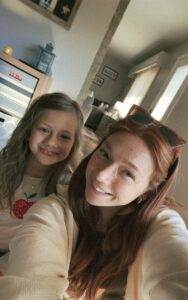My name is Auzlynd Katterhenrich, I am a junior, studying environmental science and biology. I love to do outdoorsy stuff so hiking, camping, and gardening. The picture below is me and my sister, Piper!

I thought the reading as an introduction to GIS was beneficial, It explained GIS as a useful tool to visualize data, conveying a more easily interpreted feel for a landscape as opposed to a data table. It was helpful to see how the text distinguished GISystems and GIScience, which was new to me. It explained GISystems as the use of processes like classification, digital encoding, spatial analysis, and output into software which is different from GIScience which gives theoretical bases and justifies the way the process is executed. I also thought it was interesting when the issue of categorization of spatial data was brought up. That is a good point because depending on what boundaries one is trying to create between objects or even resources, there are always grey areas or “fuzzy boundaries” that need to be represented visually. In the final pages of the reading, I found that learning about all the different ways GIS can be used and who uses it was valuable. Specifically, a concept that stood out to me was “precision farming”. This farming management concept is based on improving crop yields by responding to the crops’ variability. I think an effective way to accomplish this is through the use of GIS to visualize ideal locations for future farming through various layers like soil type, soil chemistry, wheat variety, pesticide load, and irrigation information. The use of GIS in this area can model the various factors that play a role in crop yield. Overall I found it helpful to know exactly what GIS is, how it began, what it does, and how it is used today.
I first wanted to see how GIS could be applied in missionary work and outreach and I was able to find an article called, Geographic information systems and the spiritual dimension of health: a short position paper, by Maged N Kamel Boulos. This article stated that “GIS are ideal tools for improving and coordinating the integration of the health (physical), social, and spiritual/ pastoral dimensions of individual and community care”.
Secondly, I was curious about how GIS could be applied in mapping soil erosion. I found that it could be used in erosion risk mapping to create maps that identify areas prone to soil erosion based on various factors. I found an article that looked at soil erosion in Africa that gave this map showing the Grid surface of the Keiskamma catchment showing the spatial distribution of the rainfall erosivity factor.
